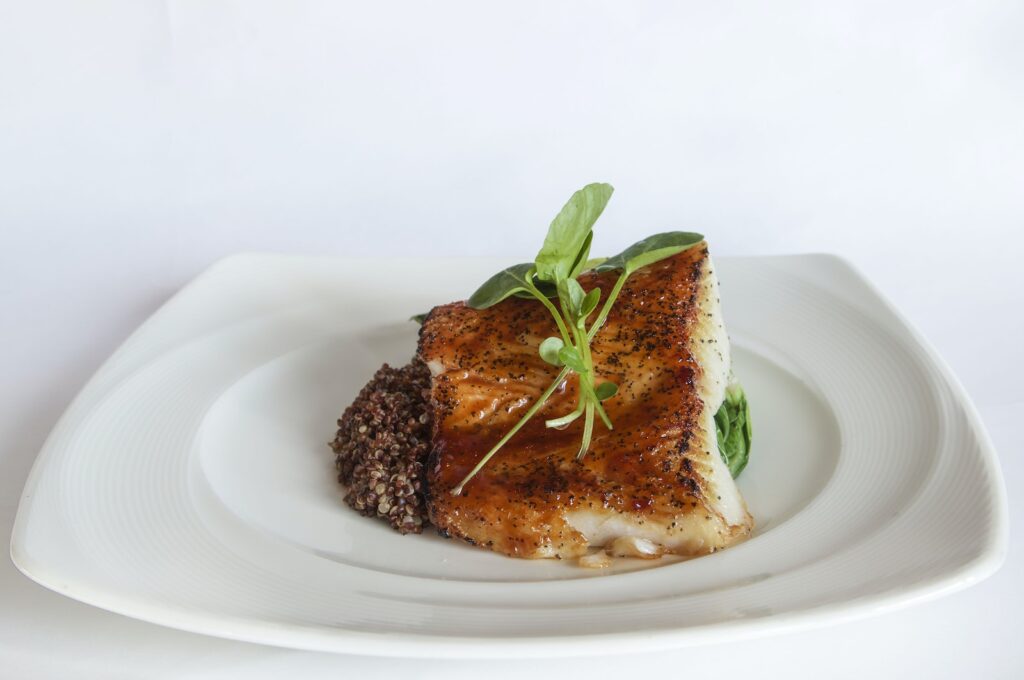Imagine strolling along the vibrant streets of a British town, and the irresistible aroma of piping hot fish and chips wafting through the air captures your attention. It’s a beloved national dish that has become an essential part of British culinary culture. But have you ever wondered how fish and chips rose to such immense popularity in the UK? Well, this article will take you on a delightful journey, uncovering the fascinating history and cultural significance of this iconic dish. Get ready to unravel the tale behind Britain’s enduring love affair with fish and chips!

Table of Contents
The history of fish and chips in the UK
Early origins of fried fish
Fish and chips have a long and fascinating history in the UK. The story begins in the early 19th century when fried fish started to gain popularity. The dish was influenced by culinary traditions brought over by Jewish immigrants from Portugal and Spain. These Sephardic Jews were accustomed to frying fish as a delicious and convenient way to prepare a meal.
Fried fish meets fried potatoes
While fried fish was gaining popularity, fried potatoes were still a separate entity in the culinary landscape. It wasn’t until the mid-19th century, when fried fish and fried potatoes would come together to create the iconic dish we now know as fish and chips. The origins of this pairing are often attributed to street vendors in East London and Lancashire who began selling fried potatoes alongside the fried fish. The combination was an instant hit.
The rise of fish and chips shops
As the demand for this delectable duo grew, dedicated fish and chips shops started to appear across the UK. These specialized establishments would fry fish and potatoes to perfection, providing a convenient and affordable meal for the working-class population. Fish and chips shops quickly became an integral part of the local communities, offering a satisfying and economical option for both lunch and dinner.
Working-class appeal
Fish and chips quickly gained popularity among the working-class population due to various factors. The dish was a nutritious and filling meal that provided an essential source of protein and carbohydrates. Additionally, the affordable pricing made it accessible to all socioeconomic backgrounds. The working-class appeal of fish and chips solidified its position as a staple in the British diet.
Role during the World Wars
Fish and chips played a crucial role during the World Wars, especially in Britain. During times of rationing, supplies of meat were scarce, making fish and chips an attractive and more readily available alternative. The government even classified fish and chips as an essential food and ensured its production continued to meet the needs of the population. Fish and chips became a symbol of resilience and sustenance.
Post-war popularity
After the hardships of the wars, the popularity of fish and chips skyrocketed. The dish emerged as a comforting and familiar comfort food in the years of rebuilding and recovery. Fish and chips shops flourished, and their distinct aroma became synonymous with British high streets. As the economy grew stronger and rationing was lifted, fish and chips maintained a special place in the hearts and stomachs of the British people.
The influence of immigration
Jewish immigrants and the introduction of fried fish
The influence of Jewish immigrants in the UK cannot be understated when tracing the history of fish and chips. These immigrants brought with them the tradition of frying fish, which eventually melded with British culinary customs. The Sephardic Jews, with their knowledge of spices and frying techniques, introduced the nation to the delectable taste of fish cooked in hot oil.
Belgian immigrants and the addition of chips
The early 19th century also saw an influx of Belgian immigrants into the UK, many of whom were skilled in the art of potato frying. These talented Belgian migrants revolutionized the fish and chips game by introducing the concept of fried potatoes or “chips” as the perfect complement to the fried fish. The marriage of Jewish fried fish and Belgian fried potatoes set the stage for the culinary phenomenon that fish and chips would eventually become.
The affordability and accessibility
Cheap source of nutrition
One of the main reasons fish and chips gained such widespread popularity was its affordability and nutritional value. As an inexpensive source of protein, fish provided the working-class population with an affordable way to fulfill their dietary needs. Paired with the economical nature of potatoes, fish and chips offered a substantial and satisfying meal that could feed families without breaking the bank.
Convenient take-away option
Fish and chips became a convenient take-away option for busy families and individuals. The dish was easily transportable, thanks to the use of newspaper as a wrapping material. People could simply make their way to the local fish and chips shop, place their order, and enjoy their meal on the go. This allowed fish and chips to fit seamlessly into the busy lifestyles of the working-class.
Presence in every town and city
One of the reasons for fish and chips’ enduring popularity is its ubiquitous presence across every town and city in the UK. Fish and chips shops became a part of the fabric of British life, with their distinct signs and inviting aromas becoming a familiar sight and smell on high streets. The accessibility and consistent quality of fish and chips ensured its place as a go-to meal option for people all over the country.
Iconic British cultural identity
Symbol of Britishness
Fish and chips have become deeply ingrained in the cultural identity of the UK. It is often seen as a symbol of Britishness, representing a nostalgic connection to the past and a sense of national pride. The dish’s association with British heritage and traditions makes it a cherished part of the nation’s culinary legacy.
Fish and chips in popular culture
Fish and chips have made numerous appearances in popular culture, from literature to movies and television. Whether it’s used to depict a quintessentially British scene or as a comforting meal shared by characters, fish and chips often serve as a cultural touchstone in media. This portrayal further solidifies the dish’s position as an icon of British culinary heritage.
Association with seaside holidays
No British seaside holiday is complete without a portion of fish and chips. For generations, families and individuals have flocked to coastal towns and enjoyed this beloved meal against the backdrop of crashing waves and seagulls. The nostalgic connection between fish and chips and seaside holidays has become an integral part of the British experience, further cementing its place in the nation’s cultural identity.

Quality and taste appeal
Traditional cooking techniques
One of the reasons fish and chips continue to captivate the tastebuds of the British population is the use of traditional cooking techniques. Whether it’s the carefully crafted batter surrounding the fish or the double-frying process of the chips, fish and chips shops pride themselves on preserving the traditional methods of preparation. This attention to detail ensures that every bite delivers the same exceptional taste and texture that has been enjoyed for generations.
Freshness of fish
The quality of the fish used in fish and chips cannot be overstated. Freshness is a key factor in ensuring the dish lives up to its reputation. Fish and chips shops take great care in sourcing their fish, often relying on local suppliers to provide the freshest catch. This commitment to quality results in fish that is tender, flaky, and bursting with flavor.
Crispiness and texture of chips
Equally important to the success of fish and chips is the texture and taste of the chips. Achieving the perfect balance of crispiness on the outside and fluffy goodness on the inside is an art form in itself. The double-frying technique gives the chips their characteristic crunch, while the softness of the potato remains intact. This ideal combination of textures elevates the dining experience and keeps customers coming back for more.
Fish and chips as a national dish
Recognition as a symbol of British cuisine
With its deep roots in British history and culture, fish and chips have gained recognition as a symbol of British cuisine. It represents the nation’s culinary heritage and is a beloved dish that crosses social and cultural boundaries. Fish and chips serve as a testament to the melting pot of influences that have shaped British cuisine throughout the years.
Officially proclaimed National Dish
In 2018, fish and chips were officially proclaimed as the UK’s National Dish by the British Parliament. This recognition solidifies the dish’s status as an essential part of the nation’s culinary identity. Fish and chips now stand proudly among other internationally celebrated national dishes, putting it on a pedestal for all to savor and enjoy.
Support from influential figures
Fish and chips have garnered support from numerous influential figures, both within and outside of the culinary world. From renowned chefs endorsing the dish to celebrities expressing their love for fish and chips, its status as a national dish has been reinforced by public figures. This collective support further promotes the dish’s significance and ensures its continued popularity.

The decline and revival
Health concerns and changing dietary habits
In recent years, fish and chips faced challenges brought on by health concerns and changing dietary habits. The high fat and calorie content of the dish caused some individuals to seek healthier alternatives. The rise of health-conscious eating, dietary restrictions, and the popularity of different cuisines all contributed to a decline in fish and chips consumption.
Competition from fast-food chains
The emergence of fast-food chains offering alternative options posed a challenge to traditional fish and chips shops. These chains offered convenient, quick-service alternatives with a diverse menu, catering to evolving consumer preferences. Fish and chips faced stiff competition, forcing shops to adapt in order to stay relevant and appeal to contemporary tastes.
Contemporary resurgence
Despite the challenges faced, fish and chips have experienced a contemporary resurgence in recent years. Many fish and chips shops have chosen to adapt and diversify their offerings, catering to health-conscious consumers by offering grilled fish, salads, and vegetarian alternatives. Additionally, a renewed interest in local and sustainable food practices has helped fish and chips regain popularity, as customers appreciate the environmentally conscious approach of some shops.
Regional variations and preferences
Differing fish choices
While cod and haddock are the most commonly used fish in fish and chips, regional preferences have led to the use of other fish varieties. For example, in Scotland, haddock is often favored, while in Northern England, cod takes center stage. Some regions even use alternatives like plaice, rock salmon, or skate. The choice of fish adds diversity to the dish and showcases the unique culinary traditions of different areas.
Variations in batter and frying techniques
Batter recipes also vary across different regions of the UK, giving rise to subtle differences in taste and texture. Some shops opt for a thicker, crispier batter, while others prefer a lighter, fluffier coating. The choice of flour, seasonings, and frying techniques play a role in creating these regional variations, resulting in fish and chips with distinct characteristics.
Accompaniments and condiments
In addition to the fish and chips themselves, the accompaniments and condiments served alongside the dish also vary across the UK. Mushy peas, curry sauce, gravy, or tartar sauce are just a few examples of the diverse range of options available. These regional variations add depth and complexity to the overall dining experience, allowing individuals to customize their fish and chips according to their preferences.
Fish and chip etiquette
The tradition of serving in newspaper
Although less common today, the traditional practice of serving fish and chips wrapped in newspaper is an iconic aspect of the dish’s history. This unique presentation harkens back to the early days of fish and chips, when newspaper was a readily available and cost-effective way to serve the meal. The ink from the newspaper would often transfer onto the food, adding a distinctive flavor to the dining experience.
Proper consumption etiquette
Fish and chips also have their own set of consumption etiquettes. Some may argue that the proper way to eat fish and chips is to use your hands, savoring each bite while enjoying the contrast between the crispy batter and the tender fish. Others may prefer to use utensils, ensuring a more refined and controlled dining experience. Ultimately, the choice is yours, and what matters most is the enjoyment of the meal.
Accompanying beverages
Another aspect of fish and chip dining etiquette lies in the choice of accompanying beverages. Traditionally, a pint of beer or a cup of tea has been the preferred pairing. The fizzy bitterness of beer or the comforting warmth of tea complement the flavors of the dish, creating a harmonious combination. However, personal preferences vary, and individuals may choose other beverages like soft drinks or even wine to accompany their fish and chips.
The future of fish and chips
Innovation and adaptation
As the culinary landscape continues to evolve, so does the future of fish and chips. Innovative techniques and adaptations are being explored to cater to changing consumer preferences and dietary needs. From gluten-free batter options to plant-based fish alternatives, fish and chips shops are finding creative ways to keep this beloved dish relevant and appealing.
Sustainability and responsible fishing
With the growing emphasis on sustainability, fish and chips shops are increasingly conscious of the importance of responsible fishing practices. Locally sourced and seasonal fish choices, as well as sustainable fishing methods, are becoming more common. By prioritizing ethical and environmentally friendly practices, fish and chips can continue to be enjoyed for generations to come.
Preserving the tradition
While innovation and adaptation are important for the longevity of fish and chips, preserving the tradition is equally crucial. Many fish and chips shops pride themselves on preserving the time-honored techniques and flavors that have made the dish a beloved British culinary icon. Balancing tradition with innovation will ensure that the future of fish and chips remains bright, satisfying the taste buds and capturing the hearts of generations to come.
In conclusion, the history of fish and chips in the UK is a tale of cultural fusion, affordability, and culinary excellence. From its humble beginnings as a pairing of fried fish and potatoes to its status as a national dish, fish and chips have earned a special place in the hearts and stomachs of the British population. As the dish evolves to meet contemporary tastes and environmental considerations, it continues to hold on to its status as an iconic symbol of British cuisine and cultural identity. Whether enjoyed by the seaside or in the heart of a bustling city, fish and chips will forever remain a beloved and quintessentially British dish.
